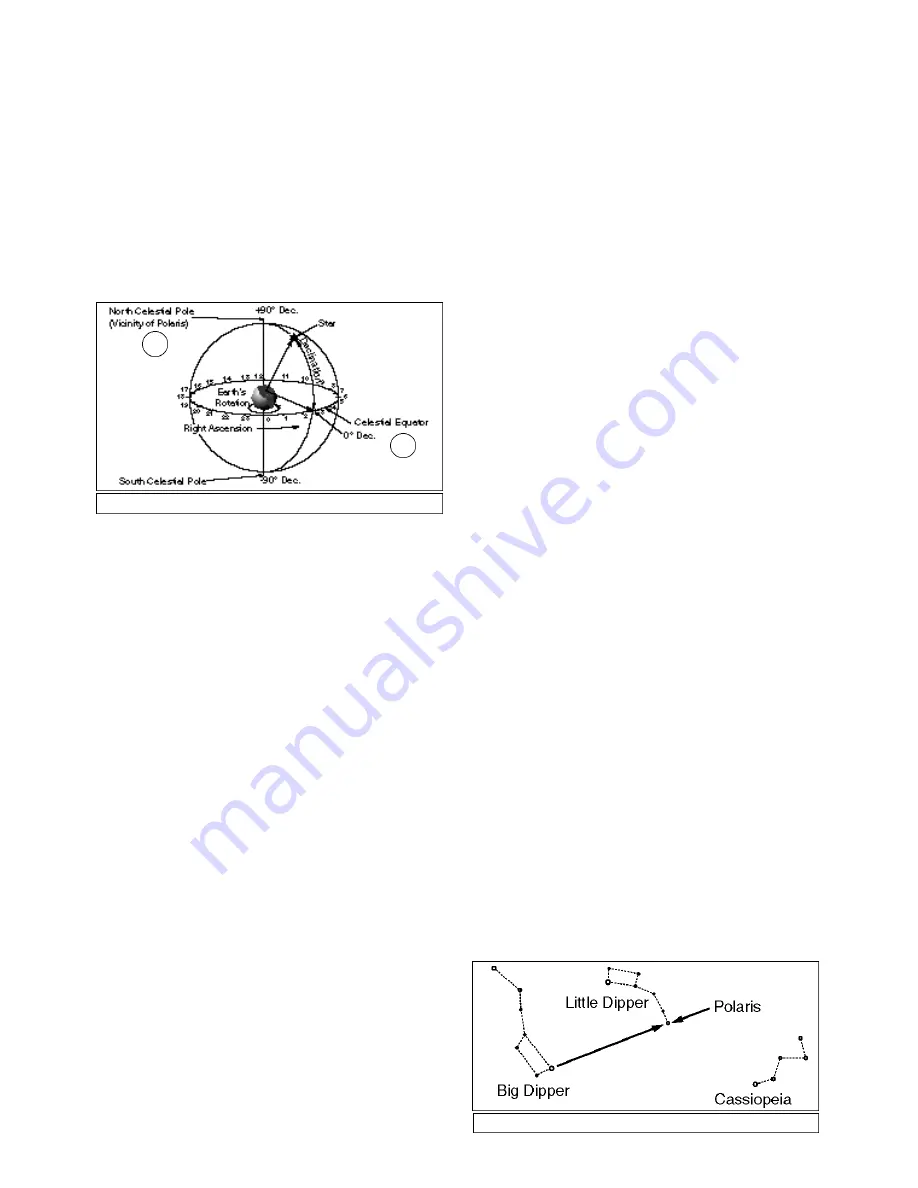
- 26 -
APPENDIX A: EQUATORIAL USE
Celestial Coordinates
Celestial objects are mapped according to a coordinate system
on the Celestial Sphere. This is the imaginary sphere surrounding
Earth on which all stars appear to be placed. This celestial object
mapping system is analogous to the Earth-based coordinate
system of latitude and longitude.
The poles of the celestial coordinate system are defined as those
two points where the Earth’s rotational axis, if extended to infinity,
north and south, intersect the celestial sphere. Thus, the North
Celestial Pole (1, Fig. 9) is that point in the sky where an
extension of the Earth’s axis through the North Pole intersects
the celestial sphere. This point in the sky is located near the
North Star, Polaris.
In mapping the surface of the Earth, lines of longitude are drawn
between the North and South Poles. Similarly, lines of latitude are
drawn in an east-west direction, parallel to the Earth’s Equator.
The Celestial Equator (2, Fig. 9) is a projection of the Earth’s
Equator onto the celestial sphere.
As on the surface of the Earth, in mapping the celestial sphere,
imaginary lines have been drawn to form a coordinate grid.
Object positions on the Earth’s surface are specified by their
latitude and longitude. You could locate Los Angeles, California,
by its latitude (+34°) and longitude (118°).Similarly, you could
locate the constellation Ursa Major, which includes the Big
Dipper, by its general position on the celestial sphere:
R.A.: 11hr; Dec.: +50°.
• Right Ascension (R.A.): R.A. is the celestial analog to Earth
longitude. It is measured in time on the 24-hour clock and
shown in hours (hr), minutes (min), and seconds (sec) from an
arbitrarily defined zero line passing through the constellation
Pegasus. R.A. coordinates range from 0hr 0min 0sec to 23hr
59min 59sec. There are 24 primary lines of R.A., located at 15°
intervals along the celestial equator. Objects located further
east of the prime R.A. grid line (0hr 0min 0sec) carry increasing
R.A. coordinate numbers.
• Declination (Dec.): Dec. is the celestial analog to Earth
latitude. It is measured in degrees, minutes, and seconds (e.g.,
15° 27' 33"). Dec. north of the celestial equator is indicated with
a plus (
+
) sign in front of the measurement (e.g., the Dec. of the
North Celestial Pole is +90°), with Dec. south of the celestial
equator indicated with a minus (–) sign. For example, the Dec.
of the South Celestial Pole is –90°. Any point on the celestial
equator, which passes through the constellations Orion, Virgo
and Aquarius, has a Dec. of zero, shown as 0° 0' 0".
Specifying the position of each celestial object by celestial
coordinates of R.A. and Dec. simplifies the task of finding objects
(in particular, faint objects). You can dial the R.A. setting circle (9,
Fig. 1) and Dec. setting circle (3, Fig. 1) to read the object
coordinates and find the object without resorting to visual location
techniques. You can use these setting circles to advantage if the
you first align the telescope with the North Celestial Pole.
Using the LX200 in POLAR Mode
The Meade 16” LX200 is an ALTAZ telescope, with little need to
mount it as an equatorial telescope. The LX200 computer and
optional field de-rotator allow tracking, slewing to objects, and
long-exposure astrophotography, all in the ALTAZ mode. In the
past, these operations required the telescope to be mounted as
an equatorial telescope. Almost any astronomy program can now
be accomplished with the telescope in the ALTAZ mode.
There is still one application that requires the telescope to be
mounted in the POLAR mode. The field de-rotator eliminates field
rotation in astrophotographs taken through the telescope. If a
secondary instrument, like a Schmidt camera, is mounted to the
telescope, astrophotographs taken through this instrument
exhibit field rotation. For these applications, the telescope
requires an equatorial setup. If you plan on doing this piggy-back
type of photography, you need an equatorial permanent pier.
Otherwise, mount the telescope on the ALTAZ permanent pier.
Lining up with the Celestial Pole
Objects in the sky appear to revolve around the celestial pole. In
fact, they are essentially fixed, and their apparent motion is
caused by the Earth’s rotation. During any 24-hour period, stars
make one complete revolution about the pole, making concentric
circles, with the pole at the center. By lining up the telescope’s
polar axis with the North Celestial Pole (or for observers located
in Earth’s Southern Hemisphere with the South Celestial Pole
(see MODEFUNCTIONS, page 17), you can follow, or track,
astronomical objects by moving the telescope about one axis, the
polar axis.
The 16” LX200 is designed to be mounted to a permanent pier for
equatorial use. Since this type of installation is permanent, it is
worth the effort to get a very accurate polar alignment of the
telescope. This process requires getting a rough polar alignment
(described below) and then using the precise polar alignment
procedure (see Precise Polar Alignment, page 27) for an exact
alignment. This process can often span several nights.
Begin polar aligning the telescope as soon as you can see
Polaris. Finding Polaris is simple. Many people recognize the Big
Dipper constellation, which has two stars that point the way to
Polaris (see Fig. 10).
To get a rough polar alignment, follow this procedure:
a. Initiate the polar alignment routine by selecting POLAR from
the ALIGN menu (when POLAR is selected, a checkmark
appears next to POLAR on the display).
b. Begin the alignment procedure by pressing ENTER.
c. As prompted, loosen the Dec. lock and rotate the telescope
tube in Dec. so that the telescope’s Dec. reads 90°. Tighten
the Dec. lock. Loosen the R.A. lock, rotate the fork arms to the
00 H.A. position, and tighten the R.A. lock. Press ENTER.
Fig. 5 shows the 00 H.A. position. The 00 line of the R.A.
setting circle aligns with the H.A. pointer. The R.A. pointer is
almost 2 hours to the right. When the telescope is rotated so
that the R.A. pointer aligns with the 00 line/H.A. pointer, this is
the 00 H.A. position.
Fig.10: Locating Polaris.
Fig. 9: The Celestial Sphere.
2
1


































